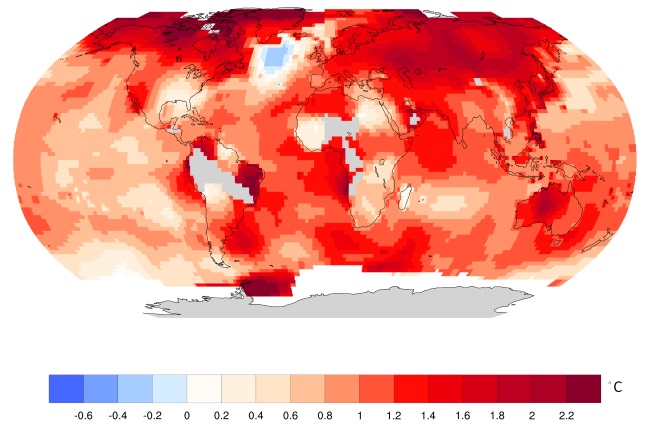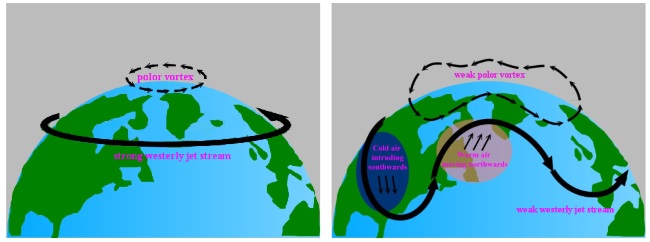"Polar Vortex" in a Warming World
27 February 2019
The year 2019 started with extreme temperatures in the two Hemispheres. In the Southern Hemisphere, Australia experienced an This link will open in a new windowextraordinary heatwave and the This link will open in a new windowhottest January on record with temperatures exceeding 49oC in parts of South Australia. In the Northern Hemisphere, the "polar vortex" brought bitterly cold temperatures to the Midwest of the United States in January. According to media reports, temperatures in Chicago fell to -30oC, even colder than parts of Antarctica. One could anticipate that climate change deniers will take this opportunity to cast doubt on the human-caused global warming whenever there are extreme cold weather events somewhere in the world (This link will open in a new windowCMS: Is Global Warming Really at Work?). The usual deniers' tactic is to conflate short-term weather fluctuations and long-term climate trends. However, short-term fluctuations in weather say nothing about long-term trends in climate (This link will open in a new windowCMS: The ABC's of Climate). As rightly pointed out by climate experts in the United States, we need to look at the big picture instead of confining our view to a short time horizon and a small area on the Earth's surface. Globally speaking, there is a lopsided ratio of hot records to cold records at land-based stations in the last 12 months, roughly about 8.3 to 1 [1]. In a longer term, almost every corner on Earth experienced a warming trend in the past 117 years (Figure 1).
What about the polar vortex? Is it undergoing any changes? As illustrated in Figure 2 for the case of the Northern Hemisphere, the polar vortex is the tight band of swirling winds in the upper atmosphere that confines cold air to the Arctic. If the polar vortex is weak, the westerly jet stream will be weakened and become wavier, favouring southward incursions of Arctic air mass, which will bring bitterly cold weather to the mid-latitudes (This link will open in a new windowCMS: Polar Vortex). A recent study reveals that weak states of the polar vortex have become more persistent in the past four decades [2] against the backdrop of global warming. Scientists put the blame on the diminishing Arctic sea ice because the uncovered ocean releases more heat to the atmosphere aloft, thereby changing the atmospheric circulation. The diminishing Arctic sea ice also contributes to the amplified warming of the Arctic through the "climate-albedo" feedback mechanism: less sea ice -> darker ocean surface exposed -> more solar heat absorbed -> further sea ice loss. The Arctic is now warming at This link will open in a new windowa rate twice the global average. Such differential warming causes the temperature contrast between the polar region and the equator to decrease, which in turn weakens the polar vortex and the westerly jet stream, making the westerly jet stream wavier and favouring outbreaks of frigid air from the north pole to the south (Blog: Warm Arctic, Cold Continents). A recent study also reveals that a warm Arctic means colder and snowier winters in Northeastern United States [3].
While more research is needed to further prove or disprove the aforementioned theory, there is no time for us to play a waiting game in the midst of climate change. The This link will open in a new windowatmospheric concentration of carbon dioxide in 2017 reached a record high of 405.5 ppm and keeps on rising. This link will open in a new windowGlobal carbon dioxide emissions in 2018 are set to hit an all-time high. If we want to achieve the goals of the Paris Agreement, significant reduction of carbon emissions is required. As pointed out by the This link will open in a new windowUN Emissions Gap Report 2018, the mitigation ambitions agreed at the Paris climate summit need to be roughly tripled if we want to contain global temperature rise to within 2oC. The mitigation ambitions would need to increase fivefold if we want to limit global warming to within 1.5oC. It's high time to step up our efforts to combat climate change.
S M Lee, F C Sham
References:
[1] Bitterly cold extremes on a warming planet: Putting the Midwest's late January record cold in perspective
This link will open in a new windowhttps://www.climate.gov/news-features/blogs/beyond-data/bitterly-cold-extremes-warming-planet-putting-midwest%E2%80%99s-late-january
[2] Winter cold extremes linked to high-altitude polar vortex weakening
This link will open in a new windowhttps://www.pik-potsdam.de/news/press-releases/winter-cold-extremes-linked-to-high-altitude-polar-vortex-weakening
[3] Warm Arctic means colder, snowier winters in Northeastern U.S.
This link will open in a new windowhttps://news.rutgers.edu/news/warm-arctic-means-colder-snowier-winters-northeastern-us-study-says/20180309

Figure 1 Warming trend during 1901-2017
(Data source: National Aeronautics and Space Administration, U.S.)

Figure 2 A stable (left) and a weak (right) polar vortex





 Local Weather
Local Weather Weather Forecast
Weather Forecast Weather Warnings
Weather Warnings Weather for Fishermen
Weather for Fishermen Weather for Marine
Weather for Marine Weather for Aviation
Weather for Aviation Weather Monitoring Imagery
Weather Monitoring Imagery GIS Weather Service
GIS Weather Service Tropical Cyclone
Tropical Cyclone China Weather
China Weather World Weather
World Weather Climate Information Service
Climate Information Service Warnings & Signals Database
Warnings & Signals Database Statistics of Special Weather Events
Statistics of Special Weather Events Monthly Weather Summary
Monthly Weather Summary Climate Change
Climate Change El Nino and La Nina
El Nino and La Nina Earthquakes
Earthquakes Tsunamis
Tsunamis Tide
Tide Geomagnetism
Geomagnetism Space Weather
Space Weather Weather Information for Astronomical Observation
Weather Information for Astronomical Observation Interactive Sun Path Diagram
Interactive Sun Path Diagram Astronomical Data
Astronomical Data Interesting Astronomical Phenomena
Interesting Astronomical Phenomena Time Services
Time Services Calendar
Calendar Almanac
Almanac Real time Radiation level in Hong Kong
Real time Radiation level in Hong Kong Understanding Radiation
Understanding Radiation Radiation Monitoring, Assessment and Protection
Radiation Monitoring, Assessment and Protection Environmental Radiation Monitoring Programme
Environmental Radiation Monitoring Programme Daya Bay Contingency Plan
Daya Bay Contingency Plan Related Sites
Related Sites Schools
Schools Travel
Travel Sports
Sports Outdoor Photography
Outdoor Photography CWOS
CWOS Senior Citizens
Senior Citizens Stargazers
Stargazers FoOb
FoOb My Little Observatory
My Little Observatory Educational Resources
Educational Resources 360 Tour of HKO
360 Tour of HKO Cloud Appreciation by Dr Tin
Cloud Appreciation by Dr Tin International Cloud Atlas
International Cloud Atlas Guided Tour
Guided Tour Courses and Activities for the Public
Courses and Activities for the Public Subscription of e-Bulletins
Subscription of e-Bulletins Research Forum
Research Forum Publications
Publications International Atomic Energy Agency
International Atomic Energy Agency Regional Specialized Meteorological Centre for nowcasting
Regional Specialized Meteorological Centre for nowcasting Asian Aviation Meteorological Center
Asian Aviation Meteorological Center Social Media
Social Media Press Releases
Press Releases What's New
What's New HKO Updates
HKO Updates LegCo Questions and Answers
LegCo Questions and Answers Observatory's Blog
Observatory's Blog Weather On-Air
Weather On-Air Cool Met Stuff
Cool Met Stuff Central Briefing
Central Briefing Tropical Cyclone Report Broadcast
Tropical Cyclone Report Broadcast Observatory's News
Observatory's News Vacancies
Vacancies Tender Notices
Tender Notices Apps
Apps Personalized Website
Personalized Website Weather Wizard
Weather Wizard Weather Information in Text
Weather Information in Text Weather Information in RSS
Weather Information in RSS Audio Web Page
Audio Web Page Forms
Forms Open Data
Open Data HKO Corporate Video
HKO Corporate Video Vision and Mission
Vision and Mission Organizational Structure
Organizational Structure Quality Management
Quality Management Hong Kong Observatory – The Facts
Hong Kong Observatory – The Facts Hong Kong Observatory 2024
Hong Kong Observatory 2024 Our Services
Our Services Programme Areas of the Observatory
Programme Areas of the Observatory History of the Hong Kong Observatory
History of the Hong Kong Observatory Career@HKO
Career@HKO Visitors Figures
Visitors Figures











